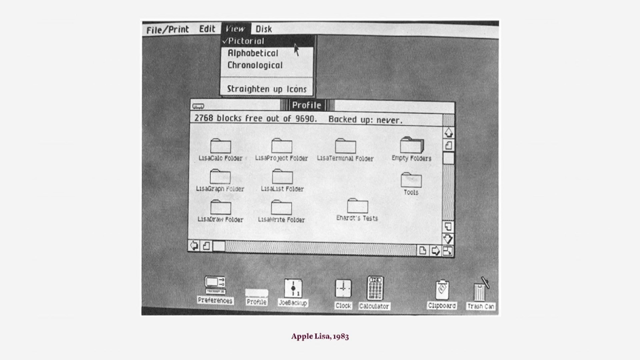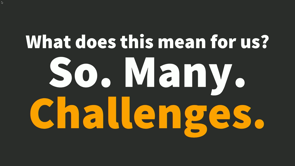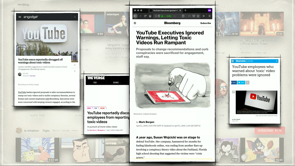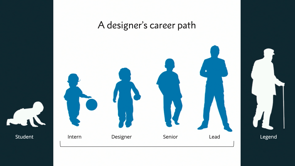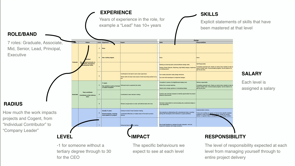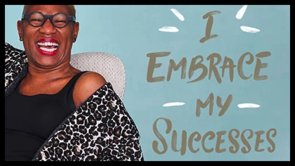
(upbeat music) (audience applauding) - So I'm just gonna tell you probably a little bit of a story about how, what we've been learning over the last 10 years or just over 10 years of corporate design are coming together in a messy, somewhat ugly way and sometimes beautiful way, to help us scale design teams.
So what I'm talking about mostly is about ambiguous futures and I wanted to start with, if the clicker will work, which it won't so I'm just gonna click there. Oops.
I want to tell you about forced experimentation and the reason I'm starting with this story is because it's a little bit like the context in which the teams that we build and the teams that I work with, work within. So some years ago, about 2014, there was a tube strike in London, and for anyone who's been to London, you would know that a tube strike in London is a fairly serious event.
And it was a part tube strike.
So what happened was that some commuters could get to work and some commuters couldn't, some lines were working, some weren't, but the system which had delivered people to work quite satisfactorily and in the same way for some years stopped working. And what people did was they started to explore alternative routes, and when they started to look back at the data at these tube strike, they found that people had started to explore in new ways, new things.
And they found that people had found better ways to work, and they found that people had explored quicker ways to work, and that people had found routes that usually they wouldn't have followed, and this led us thinking, we were talking about this at work, and we were saying this is really interesting, because usually, when we do something, we do it just to satisfy ourselves, or just to the level of which we can complete a task, but I'd like to ask you when was the last time that you did something for the first time? And if we're designers and we're trying to make or to help or to assist our businesses in thinking about things, and creating the conditions for forced experimentation, what are the constraints we need to put in place to help people try something for the first time? And I forgot the clicker doesn't work.
So who are my team? We're a team of 40.
We're a mixed team.
We are a team of service designers, strategic designers, UI designers, UX designers, CX designers, all the things that you can be in design, and we deliberately set the team up so that they can move across this, and this is probably the most difficult way to run a design team, for those of you that have tried to run a design team across multiple disciplines and not have them disparately across the group, it's very hard to do, but it actually gives us I think amazing opportunity for forced experimentation. It also creates really interesting design careers. So we have a mandate.
At IAG, which is a large insurance company for those of you who don't know, we have to do, go to this process which they call your unique value add. So you have to be able to describe what it is that your team does that nobody else exactly does the same in the business, and it's quite a good exercise, everyone learned about it at the beginning, oh, it's one of those things that HR says you have to do, turns out, it's quite empowering, and this is my team's UVA, that we create, design, and anticipate human experiences to make the complex simple, and we connect the dots and we enable transformation, and that anticipate bit was heavily argued over, and then it became one of the most important things that we do, so we think back to the tube example. One of our jobs is actually to force the conditions of experiment, so we can anticipate how people might do things differently, because that makes us both uncomfortable and do things in different ways.
So we've been on a journey of being on this sort of classic journey, there was UX design, creative design, we had HCD, we had a boot camp, we had 900 people, or 950 people who'd been through our boot camp, we had teams of UX designers delivering our digital assets, and when I came into the business, one of the things we looked at was what happens if the money runs out? And it's a really important question to ask yourself in an insurance business, because insurance is based on risk, and if you can't demonstrate really clearly how the work that you do is reducing risk of either customers or business, then you're likely to have your team reduced, and we didn't want that to happen, so we went through and we tried to evaluate exactly what we were delivering, what value it had, and how we needed to set up the team for success, and what we found was we actually needed two different things.
We needed a community, and this community had a purpose not to turn people into designers, so the classic boot camps that I'd been involved in in the past was, bring everyone in, give them a great time, hand over some Post-it notes, make some prototypes, have a fantastic time, and then move on, and what we found when we looked at what was happening in that community that people were using design as a way to escape their day jobs, and that was exactly the opposite of what we wanted to do, because what we wanted them to do was take away the idea that design could help them think differently about their world.
So what we did was we broke it apart, we found that there was sort of really three key design skills that we wanted the community to have.
First of all, we wanted them to be able to set clear objectives, what are you trying to understand? Then we wanted them to be able to investigate, and then we wanted them to be able to validate, not difficult, huh, easy.
First of all, we found out that people couldn't set objectives until we taught them how to investigate and validate, which kind of blew our minds, because for us, setting an objective in our training had set us up to start with what we were trying to solve, and actually just understanding the business found that difficult was interesting.
Then we set up a design practise and we said the role of our community is to help understand how to use design, how to frame and reframe, and how to build a better pipeline of questions, and this is really important, and I'll go into why it's important later for us. And then we said right, instead of talking about who's a UXer and who's a UI and who's at this and who's at that, and who's the other, let's look at the buckets of work that we do.
We work in experience design, and that's largely in this sort of one to five year of timeframe, how do we just make things better and improve things, how do we make sure that we're designing stuff that people can use? We've got customer experience design, which is looking at a much broader, how somebody encounters us from beginning to end, we've got innovation design and I think we started off with their thought and that might be because we, I don't know, maybe just we weren't very smart, but we thought that the innovation profile of a designer would be exactly the same as any other kind of designer, and it turns out they're not, because our innovation designers like to move really fast. They like to make things, they like to do a bit of code, they like to break things, and they like to work at a speed which is different from the designers that really thrive in the experience design space, and that's fine.
But now that we know it, we can actually help move people in the right way. And then we found this emerging space, there was this thing which we're calling future practise, and that was how do we start to anticipate the world coming towards us? And how can we work with something that's constantly turbulent, ambiguous, naive, emerging? And then what are the systems that we need underneath that to help us design for that? So our business talks about being a lean modular business, and we're saying we need a lean, modular system of design, so how do we make that? So, sorry, my laptop won't let me now do anything. We also have lockdown laptops, which means that, yes.
We decided we needed to think completely differently. We decided we needed to stop thinking entirely about design and who was a designer and what level of designer they were, and we needed to start thinking about time, 'cause what we started realising was that it wasn't about what we were trying to make, it was about the way we were perceiving time, and that if we looked at the work that we were doing, we had to look at what was catching up with those from the past, the measures, the metrics, how the business was doing, who was using our site, so mobiles, what was actually happening in the business was actually really about the past, it was what was catching up with us based on decisions we'd made previously.
If we looked at journeys, they weren't this great magical way of actually changing the future, but they were a benchmark, and they told us actually what were our customers experiencing today and how fast did we need to move away from the present and in which direction? And if we looked at the future, and for insurance, this is really massive, because the future includes things like climate change, flooding, self driving cars, and potentially the idea that we might have to become nomadic, what happens if flooding and climate change change the way we live? So as we started to look at this, we said there were measures, there were models, there was plausible, there was past, present, and future, and this really helped us start to think differently and led us to think what is it that we bring to that question? And then I encountered this really incredible person called Rafael Ramirez and he said to me one day, "You see, the thing is that strategists describe to make "and designers make to describe," and in an organisation, this is really powerful, because often what happens is the strategy department produces a 180 page deck, and they say, hey guys, we've done the strategy, then there's a bit of business planning, and then everyone goes you've got this much money and then everyone sets off and they say, you guys over there, you're making the future of mobile AI, okay? And the guys on here, they go, yeah sure and the squads get going and everybody writes an epic and everyone goes, so we're making it, got it, got it, yeah, we're making the thing, so they make the thing and they go back to the strategy guys and they go, da-dah, and the strategy guys go, that's not what I meant, that's not the future ecosystem, and they go, oh, well, like how are we supposed to know? So we noticed how was this massive space for design in the middle which was actually the space that we do best of all, which is making.
So how do we create and how do we make? Not so that people can say yes or no, but actually to help people understand and make things tangible that are currently intangible. Why is it important? Because actually, if we're going to build, and my organisation has a purpose of a safer world, if we're going to build a safer world, we have to be acutely aware of what is coming towards us, and strategists are really good at telling you what the trends are, but then we have to quickly and rapidly make something that fits into that world, so for us at the moment, one of our massive challenges is climate change. So if you live in Melbourne, it's going to be large parts of Melbourne which are going to be uninsurable potentially in the next 10 years or so.
It's gonna be large parts of Australia that are gonna be uninsurable in the next 10 years or so.
There are going to be need to be changes of housing. We're going to need to think about not can you insure everything, but what condition do you want to be in if there is a climate event that is so severe that your home is impacted in a very severe way? Are you prepared to lose everything? Are you okay with just having a photo saved, do you need a plastic box? And as one of the risks, I said to us, we should be asking not what do you want to insure, but what condition do you want to be in? And he said, this is a bad thing, and as a designer, it's really quite a good thing, because the more often things happen, the more likely that people are to change the way they behave, so back to the tube example. In a condition of forced experimentation, and if we look at this stuff that's coming towards us from the future, as a condition of forced experimentation, what should we design? So right now, we put solar panels on roofs in Sydney. Sydney has some of the worst hailstorms in the country, that kinda seems like a pretty dumb thing to do. Sounds like a great idea, let's go solar, let's put solar, but as designers, we know if we frame the problem correctly and we actually understand that problem deeply, then we won't put solar panels on roofs, we might put them somewhere else.
We might actually make roofs out of rubber, or and those roofs that were made out of rubber that now costs over $100,000 might cost less, and if we know for example in Townsville, that half the houses are still standing after the flood that happened recently and the ones that are still standing are the ones that were built as old Queenslanders, with stilts underneath them for the air to come through, and the reason they're still standing is because when that water flooded through, when it flooded through the new estates, it created massive rapid currents that absolutely wiped out every modern house. So these are really important questions.
If we're true about being design and design thinkers, how do we bring these questions to light, and how do we make that tangible for people? So we were in the middle of building, we were building future scenarios to do this. We're bringing people together into rooms and we're asking them what are your assumptions about the future? What are you most worried about coming towards you from today and what are you most worried about coming from the future, and how would you like to do it, and this artefact is something that was developed by one of the teams to help us think differently about some of the ways that we might move into the future. Doesn't an insurance company potentially need to become a builder of houses? Maybe we need to invest in new types of housing, maybe we need to not pay people out when their house gets flooded, but actually if they've been customers of ours for 10 years, we need to actually give them some money to make their house less flood, resistant.
Some of the other questions we're dealing with, I don't know how many of you have come across Sophia. Sophia is a robot, and Sophia is currently in a self driving car, this is Audi's prototypes, and we are looking at a future where if we're insurers, we're not gonna have a lot of cars to insure anymore, because if we truly are moving towards self driving cars, these cars are gonna have less accidents.
There's a whole bunch of ethics involved, and actually, it's an insurance company that's going to decide when the first self driving car hits the road, because until we can insure them and until we can agree on the legal risks of insuring self driving cars, there won't be fully self driving cars on the road, but even more than that, what happens to car parks? What happened to safety? What happens to transport? What happens to the network? So we're doing experiments around things like mobility as a service.
How does an insurance company look at its book of motor insurance and start thinking instead about the service design of mobility? And how do we look at insuring, so we know for example inner-city, Sydney in Melbourne, we've reach the point where there is 45 plus percent of zero car emission, only in the inner-city areas. But in those areas, what we're starting to see is that people are using different forms of transport. They might not own a car, they might access a car. They might use car next door, they might use GoGet, they might use UberPool. They might use Uber.
They might have a bike.
They might store that bike outside their house, or they might let someone else borrow it, but whatever is happening is that the nature of the things that they weren't using are changing.
And so we're having to design for those.
So these are the forced conditions for experiment. We're having a mini tubes, well, a major tube session redesign.
So all around us is this forced conditions for experiment and how awesome is that as a designer? You can 3D print a house in four days.
If you can 3D print a house in four days, should we be building the mansions on the coast of Sydney? If you can 3D print a house in four days, maybe houses don't look like they used to anymore. Again, really interesting design questions. How do we help people transition into this world, how do we make it affordable to live, and how do we start to design services and experiences for the changing nature of the house? Same with work.
Your house or your work and most of you know this, you will work in many places during the week, you might work in a cafe, you might work in the back of an Uber, you might work at the airport, you might work overseas on holiday, you might work on an extended journey, but effectively what we're saying is all of the things that are in your environment, your mobility, your shelter, and your work, are changing, and in those conditions for experiment, we have the opportunity to do things for the first time, and as designers, that means we have a lab in which to create prototypes that are really really really interesting and that might just change people's lives in fundamental ways, and that kinda gets me excited. I've been told not to talk too much about insurance, but I don't, I didn't mean to go and work for an insurance company, and it turns out, I've quite nerded out to it, and I'm becoming a little bit, it's like don't talk, whatever you do, don't talk about insurance at the barbecue, okay? So but it is actually much more interesting than you would think.
So, this takes me to want to make.
So you've all got versions of this in your own business. But if we're looking at this lab, and we are looking at this opportunity to do things for the first time, we actually have to systemize it, and I don't know how many of you have been through that thing where it should be lean and succinct but always, we should make it lean, it should be our job, it should be design thinking, oh, no no no no no, it should be this new model I've seen, oh, I went to a conference and I saw this model. We've got to move beyond the models.
(audience member laughs) But that was stage one, it's like we're at 2.0.
The models don't matter, and one of the things that we got asked to do, so last year, they came to us, and they said, hey, we've got a delivery problem in innovation, you guys are not delivering fast enough. I was like, okay, sounds interesting, let's have a look at what's happening here. Turns out that it was nothing to do with us not delivering fast enough, it was that we have problems that had different levels of fidelity, and you all know this, there are some problems that are naive, they're like giant jellyfish, they're enormous and they're massive and they have all sorts of questions inside them and then there are others that are like this, and if we try and apply agile to every single one of these, sure we'll have a delivery problem, 'cause we'll have stuff stuck forever up this end, because you can't use agile to solve something that you can't even see the shape of, so we said what would be a way that we could explore with unbounded curiosity, we could be like Marco Polo and explore distant exploration, but we could vigorously execute, and we have all the tools. Why are we arguing over tools, we have a toolbox, what we really need to be able to understand is how big and where does the thing sit? So up this end, in our learning options, we have our R&D teams, we have our strategic designers, we have our strategists and our trends people. In that side, our discover stages, we have people who are customer-focused who are really focusing on customer needs and inside the Accelerate, we have our builders and makers. And then we have moving into our building scale and our MPV, and none of this is new.
It's simply about what is the system around which we can encourage people to do something for the first time with the right sized problem in the right sized place? So this is how it works with mobility.
We said, how do people move? So we started looking at how we rewarded people for safety, how we started to use some of the changing technology that was inside cars to help people take safer journeys. We started looking at data that we could get, we started to look at the roads, so we can understand now, for example, how people are moving in and out of Sydney at which time.
That's not to be spooky, it's really to say how do people drive more safely, or how do we avoid things? We've started looking at ways that we can understand how to work with our partners, so we know everyone wants to change.
And one of things that is really interesting about this is that I think we've kind of reached peak corporate, don't quote me on this, because like I could get fired for this, but I think (chuckles) I think we've hit the point where with all of the design and all of the agile and all of the lead and all of the innovation that we've done, we've hit the point where actually, it's not working anymore to do this within a single corporate.
It's not possible anymore to make changes at a mobility, at a climate change, at a shelter and at a workspace in our own, and we know that because we're already working in that way in businesses and yet, our corporates keep us working in those segments, so if we've doing a lot of work recently on fraud. Did you know that right now, if you are in a car that has had an accident, a human brings all the other insurance companies to ask them whether the car that you had an accident in had another accident with them. That's sort of unbelievable to me, and so when we talk about these emerging problems for the future, how do we also focus on the present, and that's why we were looking at design systems. So we were also looking at how we work the car makers. So we know for example, last, I think it was last week or last month, I don't know, time goes quite fast, I think I'm getting old, there was a huge billion-dollar investment and that's between BMW and Daimler in Germany to look at the infrastructure for self driving cars. They're looking at the investment in new roadscapes, new service stations, and they're looking at what happens when people no longer own cars. So we have to work with those too.
And then, we need to look at how do we look at connected vehicles, how do we look at travel planning, how do we look at car sharing? And this takes us to learning options.
So I spoke earlier about these learning options, so these things here sit at the big green end of the bubble, but then we actually have to start working with partners, but fundamentally at the base of it, nothing is very different.
We're an insurance company, we protect assets. Assets change, protection changes.
The world has changed, we need to do things differently and I think as a design team, sometimes we can get lost in the little pieces and we forget the big story of what we're trying to do, so when I'm thinking about design leadership, I'm thinking about how can I help people work at the right space, when designers come to work in our team, where do they fit? What size problems do they like working at? Some of the designers I've worked with absolutely hate the ambiguity that sits in those learning options and some of them are so excited by it that they'll work, you'll have to make them go home.
Others absolutely love the continuous improvement, they're like, just give me something that's broken and help me fix this once and for all.
And neither of those are wrong or right, and I feel like we've been making designers feel bad if they don't want us at the funky end, but actually, there's so many opportunities across all of these, so what are we doing? The people who like to work in the tight end of the space are actually doing experiments. So we might be talking about how does AI work with our homes, but how do we actually explore that? I have them, I have regular brain crushes on people I meet and at the moment, one of my brain crushes is this 87 year old man called George.
When George explained AI to me, and he says it's really simple, Harriet.
He said, even a living room, there's a TV.
The TV says I'm a TV, but I don't know what I am. It says to the next to it, do you know what you are, and it goes I'm a cyborg but I don't know what I am either, and the cyborg and the TV say, hey, I'm a TV and I'm a cyborg, but we don't know what we are, do you know what you are, and it goes, I'm a rug. Yeah, I think we might be a living room, and at that point, on three pieces of data, there is a reasonably high chance that we know that that's a living room.
And those sorts of things can help us insure a house and put a price and put a value and a replacement value on a house in seconds, not minutes. How does that matter? Well, it matters once we start to design for it. In that room, what actually matters to you? Do you want the plastic box or the rubber roof, and actually, what do we design for that? So we've got people who are thinking this big, we've got people who are making.
We're pulling data from across the business just to find out how those experiments are working and how that works, and we're busy building a system of design to help these come together, because what we also found was that everybody in the business was still working in straight lines, so the present people, the future people and the past people all thought that they were doing absolutely perfect things, and they were, but they weren't connected, and there was this sort of competition and there was competition because each person got rewarded for something different. So if you start with knowing what the past is, what's causing the problem? How do we know what it is, what's going on? If you use your CX people and your journey-mapping people to tell you where those things appear in the current experience, then you can have your two streams working. You can have people fixing the stuff that just need fixing, zero to 12 months, get it done.
And you can have people working on the what happens actually if Saint Kilda becomes underwater and nobody can avoid insurance there? And in the middle, we have trade-offs, and this is the most interesting piece, because, turns out that nobody in the organisation is responsible, just as nobody in the organisation is responsible for making things, apart from designers, nobody in the organisation is responsible for configuration or the trade-offs. So we have all of this data, all of these things, but when it comes to which thing should we do first, or if you guys make a choice over here, is it gonna stop these guys moving forward, or if these guys make a choice over here, is it gonna screw up this bit over here, there's actually nobody responsible for that, and that kinda blew my mind, 'cause I was walking around going, so who here brings everyone together and says, if we change this, this changes, nobody does. Feels a little bit like a design thing to me. So what we're saying is, we have the skills to identify what happened in the past and where we are, we have the skills to map what's happening today, and we have the ability to experiment into the future. We do that each with different partners, we're working, we're not saying that designers do this by themselves, but our partnerships, our abilities to collaborate and our abilities to make decisions and work in ambiguity makes us perfectly positioned for that, and then, we encourage the conversations to make trade-offs.
Why would we build something down here, even as funky as it might be, if it doesn't actually fix the biggest problem we have, which is right here, and flexibility might be a pain point, but it's also a really interesting design context or a design constraint.
What does flexibility look like today, and what does flexibility look like in 10 years' time? So Dave Malouf talks about the three things in design, the three conditions of really successful design, serendipity, the culture of interruption, and deconstructive creativity.
And I tell one of my team, one of my team tells me, she said, I'm sick of being the project killer. Everything I go into ends up ending because it's a stupid project or it's stupid idea and I don't wanna be that person anymore.
I said, you're not that person, you're not a project killer, it's deconstructive creativity. (audience laughs) She says, oh, that's like way more empowering, so but I think we've all been there, why is it that I go into these things and I feel like I'm the negative person in the room and I'm saying this is a dumb thing? This doesn't make sense.
Why would we make this thing? It's deconstructive creativity.
So what we are working on is in order to lead design for us, we actually need to look at the conditions for forced experimentation and the world is being kind enough to be able to give us quite a lot of those, and, Porter quite, in quite a controversial way, talked about actually imposing a constraint on an economic system can change efficiency. If we look at the fact that we have forced experimentation because we have climate change, we have emerging changes in mobility, shelter, and work, then what is the design team's role, and how do we use all of these wonderful tools and practises that we've been building up for over the last 10 years of corporate or 15 years of being in corporate life? To help the business, evolve that thinking, to help them understand what's coming towards us, where we have to move and transactionally where are we most at risk, and it feels to me that this is a new kind of practise, it's a really exciting to place to work in design, and it's also something that we need to do a lot of work on, and when I came back from the UK last year, I was working on future scenarios practise with Oxford, and they said one of the biggest areas that they didn't understand was how design and how future strategy would work together, and I think we've got like an amazing opportunity to continue that, so I don't know exactly how this story's gonna end, 'cause it's a prototype, but what I do know is it's giving us some opportunities to work in some of the most interesting spaces, to do so in the most interesting work that I've been able to do in my career, I probably have a few more grey hairs than I had to start with, which I think is probably some of the stress, but it is immensely exciting, and I think it takes us from design of features and things into the design of the systems that we want to do, so that's my story, and I know I'm out of time, just about.
(upbeat music)







